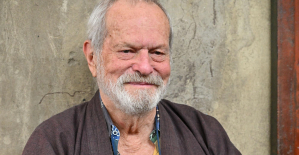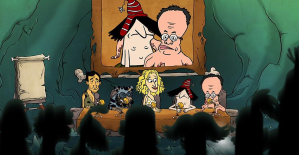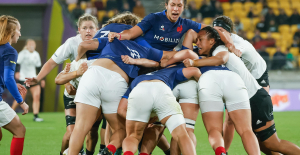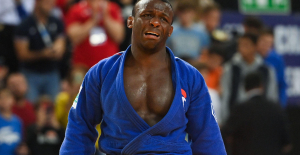Actually, the matter is clear: since September 1st, all illuminated billboards have to remain switched off at night and for most of the day. Between 10 p.m. and 4 p.m., “illuminated or light-emitting advertising systems” should not be operated, according to the Ordinance to Secure the Energy Supply on Short-Term Measures (EnSikuMaV) by Economics Minister Robert Habeck (Greens). This is how electricity is to be saved during the energy crisis. But the implementation is apparently not as easy as the ministry imagined.
On the one hand, this is due to the sheer number of illuminated billboards. Around 92,500 advertising systems are affected by the lighting ban, according to the responsible professional association for outdoor advertising (FAW). The industry is currently busy implementing the requirement. The companies are making an effort, but the regulation cannot be implemented that easily in practice.
"By far the largest part of the systems affected are analog advertising media that have so far been equipped with an automatic twilight function," says managing director Kai-Marcus Thäsler. "This twilight control must be replaced by an electrician with a timer on each individual area."
In addition, the lighting in all glazed advertising systems is a heat source, especially in the wet and cold season, which prevents the display panels from fogging up and freezing over. "In order to prevent permanent damage to the systems, heating systems would have to be installed instead of the lighting, but their energy requirements would be many times greater," argues the FAW managing director. This would finally reduce the meaning of the Energy Saving Ordinance ad absurdum if such heating systems were actually installed.
However, that seems extremely unlikely, because the conversion would probably take longer anyway than the energy saving regulation from Habeck applies. The lighting ban will end again at the end of February 2023.
According to the FAW, there is a lack of both the necessary materials and the skilled workers to quickly carry out the necessary work. "We pointed this out to the legislator at a very early stage," says Thäsler. "We have to assume that the nationwide conversion will take several months." The FAW member companies are aware of the content of the ordinance and are trying to implement the shutdown "as quickly as possible across the board".
The lighting ban could have significant financial consequences for the industry if advertisers choose not to pay, or only want to pay less. After all, your adverts will not be visible for so long on what is known in technical jargon as OOH systems. OOH stands for the English term "Out of Home" and describes forms of advertising in public spaces. According to the FAW, it is still too early to quantify the economic consequences.
"To begin with, a lot will depend on the extent to which the customers of our medium are willing to support the goals of the regulation and we will find a solution together with them as to how the temporarily limited performance of OOH can be compensated for in the interests of the customers," says Thäsler. "Here, our member companies are in intensive discussions with their customers."
Basically, the billboards are "one of the most energy-efficient media," says the FAW managing director. "Every euro of advertising that would be shifted from OOH to other media as a result of the regulation would run counter to the objectives of the regulation."
According to the association, it is not possible to quantify how much electricity can be saved by switching off the lighting, the electricity consumption of the advertising boards is subject to the company's trade secret. According to the Economics Ministry, the ordinance should save a total of around two percent of energy.
In addition to the lighting ban, numerous other measures such as the heating ban for private pools also contribute to this. "But it is already clear," says Thäsler, "that the costs for the described technical conversion of the advertising media, both in terms of energy consumption and the investments required, will far exceed the savings that can be achieved."
"Everything on shares" is the daily stock exchange shot from the WELT business editorial team. Every morning from 7 a.m. with our financial journalists. For stock market experts and beginners. Subscribe to the podcast on Spotify, Apple Podcast, Amazon Music and Deezer. Or directly via RSS feed.

 United States: divided on the question of presidential immunity, the Supreme Court offers respite to Trump
United States: divided on the question of presidential immunity, the Supreme Court offers respite to Trump Maurizio Molinari: “the Scurati affair, a European injury”
Maurizio Molinari: “the Scurati affair, a European injury” Hamas-Israel war: US begins construction of pier in Gaza
Hamas-Israel war: US begins construction of pier in Gaza Israel prepares to attack Rafah
Israel prepares to attack Rafah First three cases of “native” cholera confirmed in Mayotte
First three cases of “native” cholera confirmed in Mayotte Meningitis: compulsory vaccination for babies will be extended in 2025
Meningitis: compulsory vaccination for babies will be extended in 2025 Spain is the country in the European Union with the most overqualified workers for their jobs
Spain is the country in the European Union with the most overqualified workers for their jobs Parvovirus alert, the “fifth disease” of children which has already caused the death of five babies in 2024
Parvovirus alert, the “fifth disease” of children which has already caused the death of five babies in 2024 Falling wings of the Moulin Rouge: who will pay for the repairs?
Falling wings of the Moulin Rouge: who will pay for the repairs? “You don’t sell a company like that”: Roland Lescure “annoyed” by the prospect of a sale of Biogaran
“You don’t sell a company like that”: Roland Lescure “annoyed” by the prospect of a sale of Biogaran Insults, threats of suicide, violence... Attacks by France Travail agents will continue to soar in 2023
Insults, threats of suicide, violence... Attacks by France Travail agents will continue to soar in 2023 TotalEnergies boss plans primary listing in New York
TotalEnergies boss plans primary listing in New York La Pléiade arrives... in Pléiade
La Pléiade arrives... in Pléiade In Japan, an animation studio bets on its creators suffering from autism spectrum disorders
In Japan, an animation studio bets on its creators suffering from autism spectrum disorders Terry Gilliam, hero of the Annecy Festival, with Vice-Versa 2 and Garfield
Terry Gilliam, hero of the Annecy Festival, with Vice-Versa 2 and Garfield François Hollande, Stéphane Bern and Amélie Nothomb, heroes of one evening on the beach of the Cannes Film Festival
François Hollande, Stéphane Bern and Amélie Nothomb, heroes of one evening on the beach of the Cannes Film Festival Skoda Kodiaq 2024: a 'beast' plug-in hybrid SUV
Skoda Kodiaq 2024: a 'beast' plug-in hybrid SUV Tesla launches a new Model Y with 600 km of autonomy at a "more accessible price"
Tesla launches a new Model Y with 600 km of autonomy at a "more accessible price" The 10 best-selling cars in March 2024 in Spain: sales fall due to Easter
The 10 best-selling cars in March 2024 in Spain: sales fall due to Easter A private jet company buys more than 100 flying cars
A private jet company buys more than 100 flying cars This is how housing prices have changed in Spain in the last decade
This is how housing prices have changed in Spain in the last decade The home mortgage firm drops 10% in January and interest soars to 3.46%
The home mortgage firm drops 10% in January and interest soars to 3.46% The jewel of the Rocío de Nagüeles urbanization: a dream villa in Marbella
The jewel of the Rocío de Nagüeles urbanization: a dream villa in Marbella Rental prices grow by 7.3% in February: where does it go up and where does it go down?
Rental prices grow by 7.3% in February: where does it go up and where does it go down? Even on a mission for NATO, the Charles-de-Gaulle remains under French control, Lecornu responds to Mélenchon
Even on a mission for NATO, the Charles-de-Gaulle remains under French control, Lecornu responds to Mélenchon “Deadly Europe”, “economic decline”, immigration… What to remember from Emmanuel Macron’s speech at the Sorbonne
“Deadly Europe”, “economic decline”, immigration… What to remember from Emmanuel Macron’s speech at the Sorbonne Sale of Biogaran: The Republicans write to Emmanuel Macron
Sale of Biogaran: The Republicans write to Emmanuel Macron Europeans: “All those who claim that we don’t need Europe are liars”, criticizes Bayrou
Europeans: “All those who claim that we don’t need Europe are liars”, criticizes Bayrou These French cities that will boycott the World Cup in Qatar
These French cities that will boycott the World Cup in Qatar Medicine, family of athletes, New Zealand…, discovering Manae Feleu, the captain of the Bleues
Medicine, family of athletes, New Zealand…, discovering Manae Feleu, the captain of the Bleues Football: OM wants to extend Leonardo Balerdi
Football: OM wants to extend Leonardo Balerdi Six Nations F: France-England shatters the attendance record for women’s rugby in France
Six Nations F: France-England shatters the attendance record for women’s rugby in France Judo: eliminated in the 2nd round of the European Championships, Alpha Djalo in full doubt
Judo: eliminated in the 2nd round of the European Championships, Alpha Djalo in full doubt


















